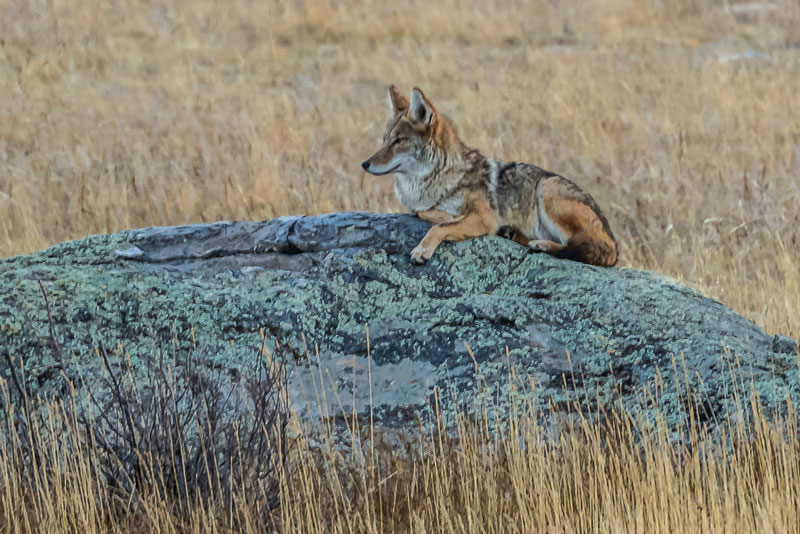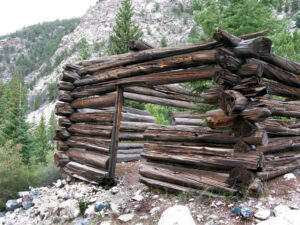By Tina Mitchell
In 1961, I was a 10-year-old kid in the suburbs of Chicago and Walt Disney had me smack dab in his sights. “The Wonderful World of Disney” had become “must see TV” every Sunday evening in my house. With “Bambi,” he had brought wildfire to life (and, rightly or wrongly, mother-killing hunters to scourge). Thanks to “Lady and the Tramp,” I developed a deep distrust of dogcatchers. I’d never seen a coyote in the wild. But I was about to become a fierce coyote advocate.
The coyote is a member of the Canis genus roughly the size of a small, lanky German Shepherd dog: 32-40 inches long, 30-50 pounds. The back is tawny gray; the face, forelegs and ears tend to be reddish to brownish buff. The throat and belly are paler than the rest of the body and the 14-inch bushy tail, usually held low, sports a black tip.
Both a pursuit predator and scavenger, a coyote eats animal matter first and foremost (roughly 90% of the diet), featuring rodents (important in winter) and lagomorphs (jackrabbits and cottontail rabbits, important in summer). Coyote predation on big game and livestock usually targets younger animals such as fawns or calves. Carrion (winter kill, roadkill) can help a coyote survive a tough winter. In summer, grasshoppers become important; and favorite plant material consists of fruit, berries and cultivated crops such as melons and carrots.
Coyotes are monogamous, often mating for life. Females come into breeding condition for about five days a year, usually between January and March. These can be tricky days for human-coyote interactions, since the males are hopped up on testosterone. Gestation takes about 63 days and litters average five or six pups. From May until August (roughly), the adults have pups to protect, creating another challenging time for human-coyote interactions. Advocate tip #1: If a coyote emerges—present but not threatening—to watch a hiker and her dog, they’ve likely approached too close to a den. (Based on a true story. Mine.) Just leash your dog, keep walking and calmly allow yourself to be escorted away. As summer ends, coyotes increasingly rely on vocal communications as the group scatters. The scientific name reflects this characteristic: Canis latrans, Latin for “barking dog.” (“Coyote” derives from coyotl, an Aztec word for this species.)
Myths and negative attitudes surround coyotes. In Colorado, they are classified as furbearers and can be hunted, with the appropriate license, year-round, no possession limits. Much of the disdain for coyotes originated within the livestock industry, whose assets (i.e., livestock) sometimes ran afoul of predators. Increasing industry pressure resulted in the Bureau of Biological Survey, a federal agency that morphed into the U.S. Fish and Wildlife Service. In the early 20th century, the Bureau branded itself as the solution to predation by mounting a poison-based eradication campaign: Strychnine was placed in carcasses, which scavenging coyotes readily consumed. (Ranchers may have been pleased; but farmers soon faced an onslaught of voracious rabbits devouring their crops, due to the removal of a major predator.) Simultaneously a concerted effort using fictional stories cast aspersions on these animals.
Considering their tarnished reputation, coyotes’ adaptability has been nothing short of astounding. Originally found only in the West, coyotes have increased their range by 40% since the 1950s, inhabiting every state except Hawaii. Wolves were essentially wiped out in the U.S. by 1925. But coyotes more than survived attempts to eradicate them. They flourished. What did they have that wolves didn’t? Wolves are obligate pack animals; hunters discovered if you could track one, you could obliterate the entire pack. Coyotes also live in groups when it’s advantageous. But when it’s not, they disperse into pairs or even solitary individuals, making them difficult to locate and eliminate. Moreover, when coyotes sense their numbers dwindling, their litter sizes increase—an unusual capacity called compensatory breeding. An adage claims, “If you kill one coyote, six will come to the funeral.” For this species, culling to permanently reduce numbers is but a pipe dream.

Around the middle of the century, the animator Chuck Jones started what would become a sea change around attitudes toward coyotes. Wile E. Coyote starred not as a menacing danger but as the inept, hapless pursuer of Road Runner—a creature you could feel sorry for. By the early 1960s, though, a cultural icon took a determined stand for the coyote. In 1961, Walt Disney produced an hour-long animated feature for “The Wonderful World of Disney”—“A Coyote’s Lament”—marking the first of six such shows. And I watched every one. After a decades-long campaign to brainwash Americans against it, the coyote became a sympathetic creature.
And I, as a rapt follower of “Uncle Walt,” took up a new lifelong cause.
Many wildlife agencies today maintain a fairly hands-off approach to coyote management, using education, hazing (nonlethal approaches such as making noise, chucking rocks) and sometimes closing down open spaces if issues arise. Removal functions only as a last resort. Wildlife officers don’t remove coyotes for being coyotes. It’s the humans who are extremely difficult to train.
Native to North America, the coyote’s barks, yips and howls might be considered our original national anthem. Thanks to millions of years of genetic fine-tuning, coupled with thousands of years’ experience adjusting to humans, coyotes have adapted to whatever hardships we have tried to impose. As we continue to co-exist with Canis latrans, let’s keep these “barking dogs” wild. Keep them a little spooked by us rather than nonchalant. Advocate tip #2: Carry a small air horn and send out a short blast when you encounter one. Usually it’ll bolt away. Advocate tip #3: Carry a runner’s pepper spray container, just in case.
It’s good for them to think that we’re a little too weird for them to relax.
After 25 years of watching the natural world in Colorado, Tina now watches it in San Diego County, California. There she works to protect her tiny corner of the planet through wildlife rehabilitation and outdoor education with elementary school kids—two load-bearing columns of Nature’s future.
The Natural World is sponsored by Ann and Henry Klaiman.



I would like to commend Christina Mitchell for her interesting and entertaining article on coyotes. I especially enjoyed the practical information on what to do if I encounter one, since they can be large and scary and furtive.
I would like to read more from this writer.
Edith Richman